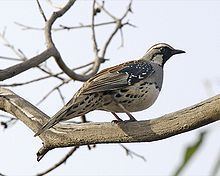Suborder Passeri Rank Family | Class Aves Phylum Chordata Order Passerine | |
 | ||
Similar Quail‑thrush, Australasian treecreeper, Orthonychidae, Sittella, Australo‑Papuan babbler | ||
Psophodidae is a family of passerine birds native to Australia and nearby areas. It has a complicated taxonomic history and different authors vary in which birds they include in the family. It includes at least the quail-thrushes (Cinclosoma), 8 species of ground-dwelling birds found in Australia and New Guinea. The jewel-babblers (Ptilorrhoa), 4 species found in rainforest in New Guinea, also seem to belong in this family.
Contents
The whipbirds and wedgebills (Psophodes and Androphobus) are also included. The Malaysian rail-babbler (Eupetes macrocerus) was formerly sometimes placed in this family which would then be called Eupetidae.
Taxonomy
The quail-thrushes, jewel-babblers, whipbirds and wedgebills were traditionally included with the logrunners (Orthonyx) in the family Orthonychidae. Sometimes the Malaysian rail-babbler and blue-capped ifrit (Ifrita kowaldi) were also included in the family. In 1985, Sibley and Ahlquist found that the logrunners were not related to the others and included only the logrunners in the Orthonychidae. They treated the others as the subfamily Cinclosomatinae within their expanded family Corvidae.
A numbers of authors later treated the quail-thrushes and allies as the family Cinclosomatidae, a name first coined by Gregory Mathews in 1921–1922. However, if the whipbirds are included in the family, the older name Psophodidae Bonaparte, 1854 has priority. If the Malaysian rail-babbler is also included, the name Eupetidae Bonaparte, 1850 has priority.
The Malaysian rail-babbler has now been shown to be unrelated to the others, probably being an early offshoot of the Passerida. Another study found the quail-thrushes and jewel-babblers to be related to each other but did not show them to have a close relationship with Psophodes or Ifrita.
Description
The quail-thrushes and jewel babblers are medium-sized songbirds, 17–28 cm in length. They have strong legs and bills. Males and females often differ in plumage markings. The quail-thrushes are largely brown above, the colour varying to provide camouflage against the soil, but are more boldly marked with black and white below. Jewel-babblers usually have extensive blue in their plumage. Most species have loud, distinctive songs.
Whipbirds and wedgebills are 19–31 cm long. They are mainly olive-green or brown in colour and have a crest.
Distribution and habitat
Jewel-babblers are found on New Guinea and the neighbouring islands of Yapen, Batanta, Misool and Salawati. They occur in forest, generally replacing each other at different altitudes. The painted quail-thrush is also found in the forests of New Guinea. The other quail-thrushes are restricted to Australia where they are found in drier habitats, occurring in open forest, scrub and on stony ground. None of the species are thought to be threatened but one subspecies of the spotted quail-thrush is possibly extinct.
The whipbirds and wedgebills are all found in Australia, occurring in a range of habitats from rainforest to arid scrub. The western whipbird is considered to be near-threatened because of habitat loss and fires while the Papuan whipbird is classed as data deficient.
Behaviour
They are terrestrial birds which fly fairly weakly and prefer to squat or run when disturbed. They forage on the ground feeding mainly on insects and other invertebrates. In the desert, quail-thrushes also eat some seeds.
They build a cup-shaped nest among shrubs or on the ground. Two or three eggs are laid.
Species list
If the following species are included, the family becomes Psophodidae:
